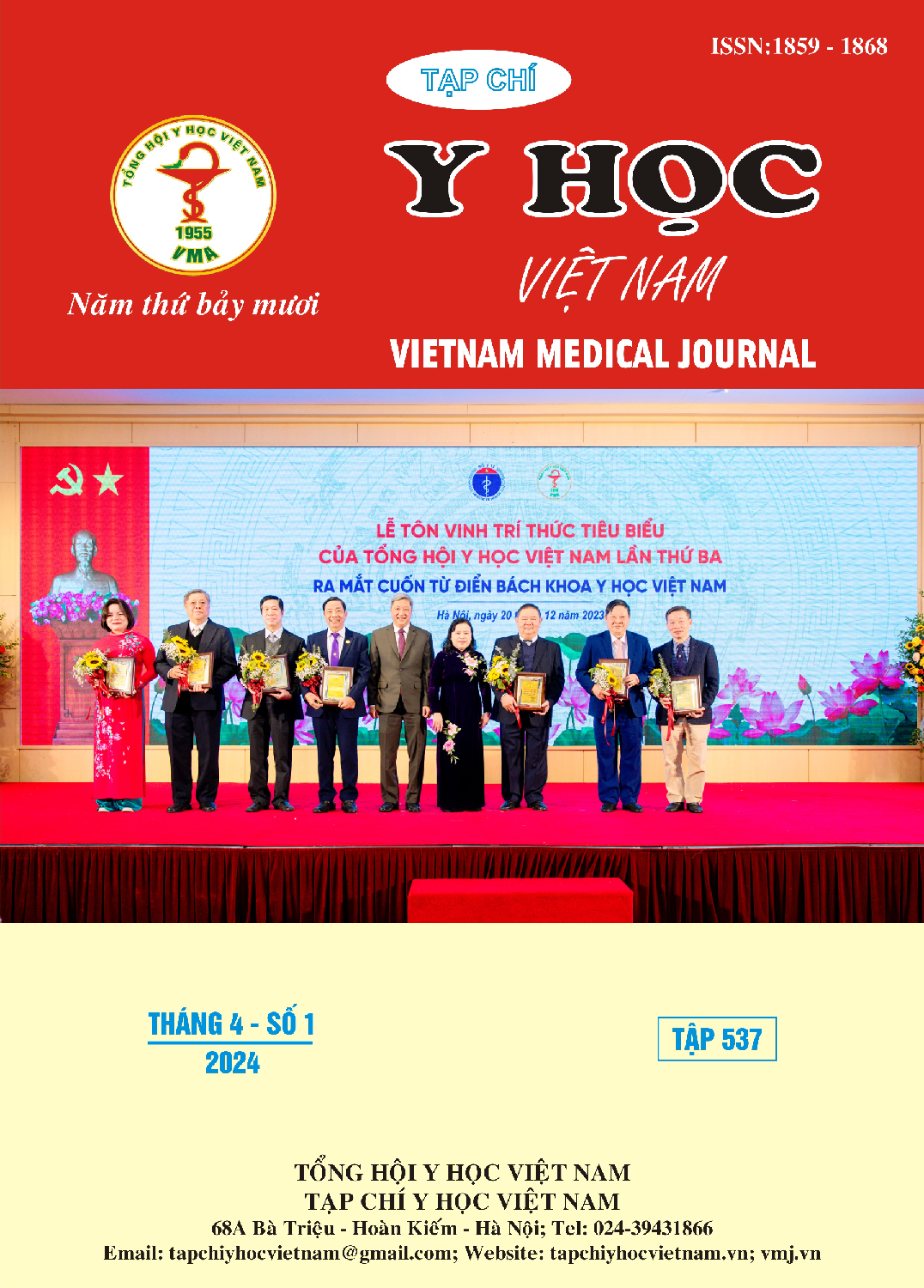COMMENTS ON SOME CLINICAL AND PARACLINICAL CHARACTERISTICS, ANALYZING FACTORS ASSOCIATED WITH AXILLARY LYMPH NODE METASTASIS IN BREAST CANCER PATIENTS
Main Article Content
Abstract
The study describes clinical, paraclinical characteristics and analyzes the relationship of some of these with axillary lymph node metastasis in patients with stage I to IIIA breast cancer underwent radical surgical treatment at 103 Military Hospital, from January 2020 to May 2023.The results showed that: average age was 53.4±1.7 (26-84), 41.0% of patients were still menstruating, and 59.0% were menopausal. In most cases, the disease was detected because the patient feels the breast tumor themselves (accounting for 96.7%), the most common location of tumor was the upper - outer quadrant (rate of 59.0%), and the tumor often had unclear boundaries, firm and poor mobility (rate of 67.2%, 88.5% and 52.5% respectively), nipple abnormalities rate was 14.6%, including: inversion (11 .4%), drainage (1.6%), and inflammation (1.6%). On ultrasound, the majority of tumors had hypoechoic characteristics (rate 88.5%), mainly with Birads grades IV and V (rate of 72.1 and 19.7%). The invasive ductal carcinoma type accounts for the majority (75.4%), with the luminal subtype B having the highest rate (58.3%). The group of tumor size over 2cm and the loss of lymph node hilus structure on ultrasound increased the rate of axillary lymph node metastasis (p < 0.05).
Article Details
Keywords
Breast cancer; mammary ultrasound; axillary lymph node metastasis.
References
2. Sung H., Ferlay J., Siegel R. L., Laversanne M., Soerjomataram I, Jemal A, Bray F. Global Cancer Statistics 2020: GLOBOCAN Estimates of Incidence and Mortality Worldwide for 36 Cancers in 185 Countries. CA Cancer J Clin. May 2021;71(3):209-249. doi:10.3322/caac.21660
3. Kone A, Diakite A, Diarra I, Diabate K. Epidemiological and Clinical Profile of Breast Cancer at Bamako Radiotherapy Center. Journal of Cancer Therapy. 2019;10:739-746. doi:10.4236/jct.2019.109062
4. Phùng Thị Huyền. Đánh giá kết quả hoá trị bổ trợ kết hợp trastuzumab trên bệnh nhân ung thư vú giai đoạn II, III. Đại học Y Hà nội; 2016.
5. Bùi Đặng Minh Trí, Trần Minh Sang, Trần Văn Kha. Lâm sàng, cận lâm sàng bệnh nhân ung thư vú điều trị bằng cyclophosphamid. Tạp chí Y học Việt Nam. 09/23 2022;518(1) doi:10.51298/vmj.v518i1.3346
6. Ghaemian N, Haji Ghazi Tehrani N, Nabahati M. Accuracy of mammography and ultrasonography and their BI-RADS in detection of breast malignancy. Caspian journal of internal medicine. Fall 2021;12(4):573-579. doi:10.22088/ cjim.12.4.573
7. Lê Hồng Quang, Đoàn Minh Thế. Đánh giá tình trạng di căn hạch nách và một số yếu tố liên quan trên bệnh nhân ung thư vú giai đoạn I – IIIA tại Bệnh viện K. Tạp chí Y học Việt Nam. 04/26 2022; 512(2) doi:10.51298/ vmj.v512i2.2273
8. Tạ Văn Tờ. Nghiên cứu hình thái học, hóa mô miễn dịch và giá trị tiên lượng của chúng trong ung thưu biểu mô tuyến vú. Luận án Tiến sĩ Y học. 2004.
9. Nguyễn Văn Qui. Nghiên cứu chẩn đoán và điều trị ung thư vú giai đoạn I-III ở phụ nữ tại Bệnh Viện Đa Khoa Cần Thơ. Luận án Tiến sĩ Y học. 2007.
10. Nguyễn Bá Mạnh. Đánh giá kết quả phẫu thuật Patey cải biên trong điều trị ung thư vú giai đoan I, II, IIIA tại Bệnh viện Việt Tiệp Hải Phòng. Luận văn cao học. 2013.


